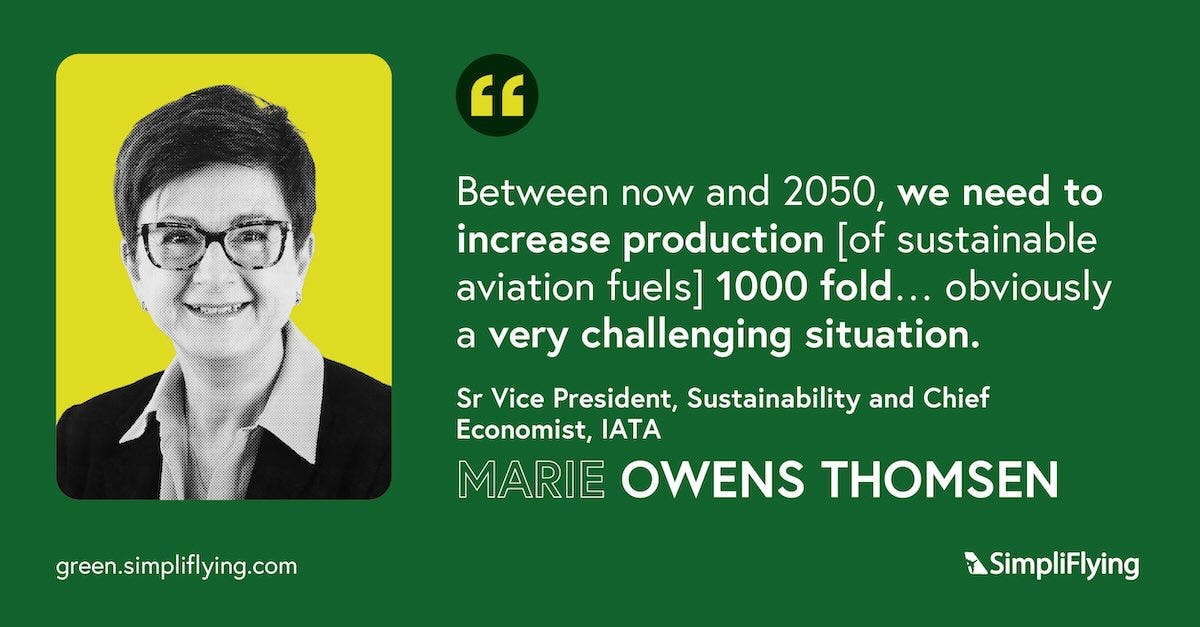In this episode, we talk to Marie Owens Thomsen, Senior Vice President Sustainability & Chief Economist at the International Air Transport Association (IATA), on the integration of sustainability and economics within the aviation sector.
Thomsen articulates a comprehensive vision for the aviation industry’s sustainable future while highlighting the complexities and challenges inherent in this transition.
She emphasises the need to balance economic considerations and environmental sustainability, advocating for a systemic approach that extends beyond aviation. She also delves into the nuances of SAF production, underscoring the importance of diversifying and scaling technological pathways for SAF.
Here are the key highlights of the conversation:
Merging sustainability and economics in the aviation industry (4:14)
Sustainable aviation fuel production and decarbonisation (8:04)
Creating a global SAF registry and accounting system for airlines (24:37)
Sustainable aviation fuel and its production pathways (36:03)
Aviation industry’s decarbonisation efforts and criticisms (38:45)
Hopes for the future (48:31)
Rapid Fire! (51:21)
Keep reading for a quick overview of the episode.
Why the intersection of sustainability and economics in aviation matters
To enable the transition towards net zero, Thomsen advocates for a strategic integration of sustainability with economic considerations.
With the pressing demands of climate change looming large, she emphasises the need for a systemic and holistic strategy that transcends the boundaries of aviation to include a broader coalition of stakeholders, including energy producers, policymakers, and financial institutions.
This collaboration is critical for charting a sustainable future, though Thomsen notes the inherent challenges in broadening the scope of these discussions beyond the aviation sphere.
Thomsen also acknowledges the paradigm shifts needed in the trajectory of the aviation industry that has traditionally been driven by growth metrics alone.
She believes that pursuing sustainability lies in the interest of the aviation industry, especially given the substantial economic burden of fuel costs. The industry’s proactive efforts to minimise energy consumption and enhance operational efficiency are evidence of the commitment to balancing economic viability with environmental stewardship, she adds.
5 ways IATA is thinking about sustainable aviation
1. The critical role of Sustainable Aviation Fuels
Thomsen identifies SAF as a cornerstone for decarbonising aviation, highlighting its potential to replace fossil fuels without necessitating new aircraft designs or infrastructural overhauls.
Despite the promise of SAF, Thomsen points to the daunting challenge of scaling up SAF production to meet future demands – a task that requires unprecedented collaboration with the oil and gas sector, which controls the essential infrastructure and production capabilities.
2. Investment shifts towards renewable energy
Thomsen underscores the significant influence of public investment on guiding private-sector funding towards sustainable initiatives.
Noting the significant disconnect between the public commitments made under the Paris Agreement and the actual financial flows, which have increasingly favoured fossil fuel subsidies, Thomsen highlights the dire need to pivot these finances towards renewables.
She suggests that governments must lead the shift towards sustainability by offering necessary support and investment in renewable energy, sending strong signals to the private sector to effectively follow suit.
“Private money will follow public money. Today, lots of public money goes into oil and gas... Governments need to reorient their financial and other support for renewable energies. If they don’t do that, the money will continue to go into oil and gas and nobody will make any progress.”
3. IATA’s pivotal role in enhancing SAF accessibility
Thomsen highlights the necessity of a comprehensive SAF accounting system or registry to ensure equitable access to SAF for all countries and airlines.
She envisions a significant role for IATA in spearheading the development of the infrastructure required for a global SAF market. Leveraging its experience with the airline industry’s financial clearinghouse, IATA could efficiently manage SAF transactions, democratising access to SAF and reducing logistical barriers and costs for airlines worldwide, especially those in regions underserved by SAF production.
“We don’t want to exclude airlines from the market, just by the fact that they happen to be located in a place with no SAF. We also want airlines to be able to claim their SAF purchases against their decarbonisation obligations.”
4. Confronting the green premium
Currently, there remains a significant cost difference between SAF and jet fuel – with SAF being 3-5 times more expensive than jet-A. The push for transition towards SAF has raised questions about how this extra cost or “green premium” will be managed.
Thomsen outlines the historical strategies employed by airlines to manage fluctuating fuel costs – absorbing extra costs into their profit margins or passing increased expenses onto consumers.
She highlights the precarious financial position of the aviation industry, which is characterised by slim profit margins and the constant challenge of balancing operational costs with competitive ticket pricing.
It is likely that airlines will resort to a similar strategy to manage the SAF expenses, says Thomsen, although it is widely believed that the green premium will be passed onto airline customers.
“Historically, we see that airlines have pretty much used the two options that are available to them – either [taking on the] extra costs onto their profit margins and absorbing them themselves, resulting in lower profit margins... or, indeed, they try to pass these costs onto the passengers. And, and historically, again, airlines have used both of these levers.”
5. Collaborative efforts beyond aviation
Reflecting on IATA’s engagement with stakeholders outside the aviation sector, Thomsen acknowledges the embryonic yet promising efforts to foster collaboration with governments, financial institutions, and energy producers.
She cites the CAAF conference as an example of constructive dialogue with government representatives, highlighting the importance of such interactions in shaping policies conducive to the aviation industry’s sustainable transition.
Thomsen also emphasises the ongoing initiatives aimed at establishing the necessary market infrastructure to support a global SAF market, including the development of model procurement contracts and a SAF accounting framework.
‘Sustainability in the Air’ is the world’s leading podcast dedicated to sustainable aviation. Through in-depth conversations with top aviation leaders, we break through the clutter and provide a clear roadmap for a net-zero future.













